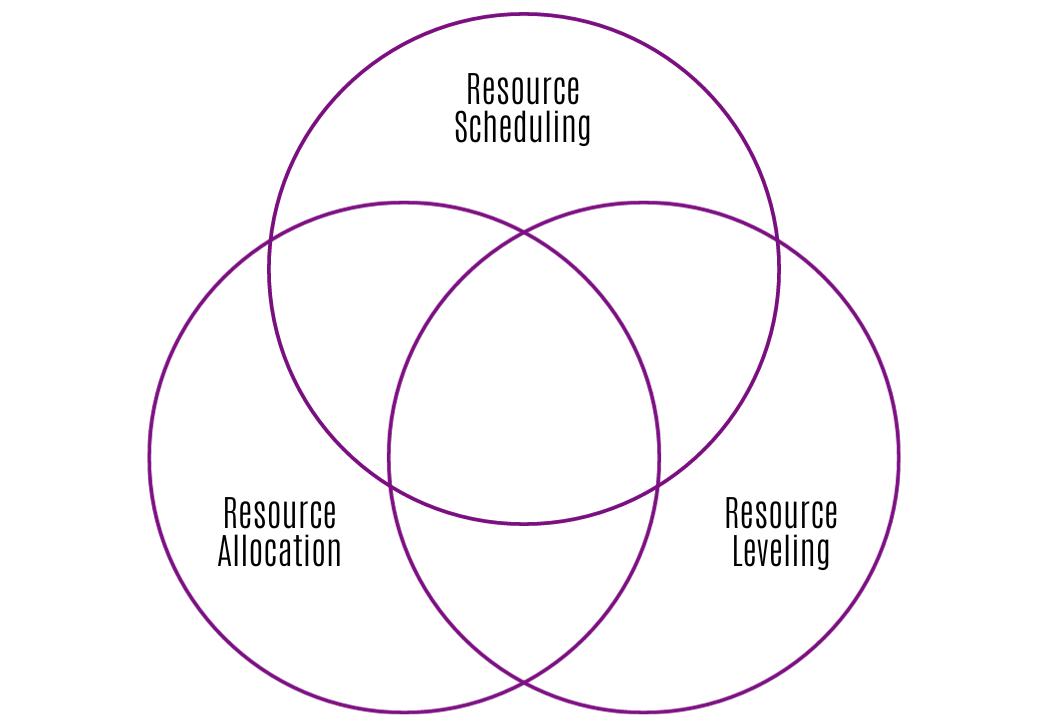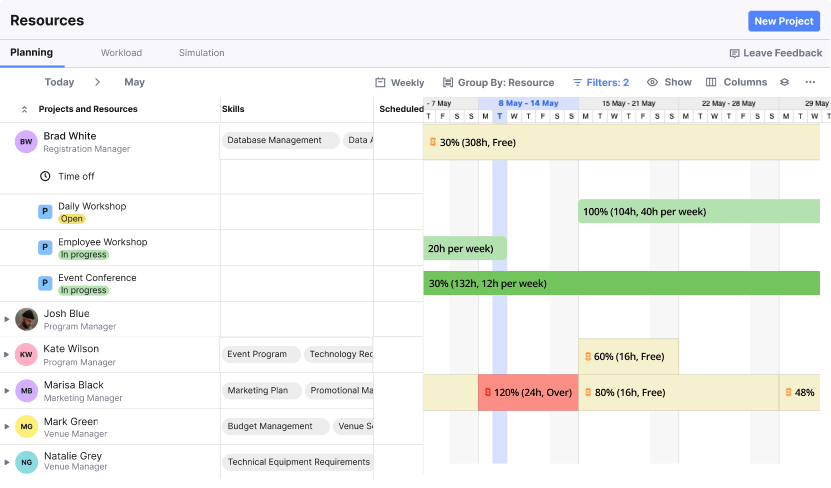What is Resource Allocation in Professional Services?
Resource allocation in professional services is the allocation of various resources to optimize service delivery. These resources may include personnel, time, finances, and other assets necessary to provide professional services.
The goal is to allocate resources efficiently to meet customer needs and ensure project success.
Key aspects of resource allocation in professional services include:
Personnel Assignment: Finding and assigning individuals with the required skills and experience for specific projects or tasks.
Time Management: Effectively plan and track employees’ time to meet project deadlines.
Financial Planning: Budgeting and managing financial resources and controlling project costs to ensure projects are delivered within the allocated budget.
Workload Balancing: Distributing work among team members to avoid overload and effectively utilize everyone’s skills.
Risk Management: forecasting, identifying, and managing potential risks associated with resource allocation to minimize in-service delivery.
Adaptability: Flexibility and adjustment of resource allocation in response to customer requirements or problems encountered.
Collaboration: Maintaining communication channels to keep both clients and team members informed with a free Client portal about resource allocation plans, progress, and any adjustments made.
Visualize yourself as the maestro of a grand symphony, poised for a virtuoso performance. Just as each instrument contributes a unique timbre to create an exquisite harmony, resource allocation is the key to orchestrating a triumphant project. Welcome to our comprehensive guide on resource allocation in Professional Services, where we’ll explore the intricacies of this indispensable practice, its profound significance, the challenges it presents, and the tools that can elevate your skills to new pinnacles.
Managing Resources in Projects within Professional Services
Resource allocation is akin to assembling a mosaic of intricate beauty. It involves meticulously disseminating diverse resources – including human capital, equipment, financial assets, and temporal facets – across the mosaic of project tasks to ensure a seamless synthesis, much like the delicate placement of mosaic tiles to compose a masterpiece.
The Significance of Resource Allocation in Profesional Services
Resource allocation in Professional Services is not merely a mundane chore; it stands as the linchpin that can shape the destiny of your project. Here’s why it holds such a paramount role:
- Timely Project Completion: Proper resource allocation serves as the North Star guiding your project to a timely denouement.
- Budgetary Vigilance: It functions as a bulwark against budgetary excess, preventing financial hemorrhage.
- Vanguard of Quality Assurance: Resource allocation acts as the vigilant sentinel safeguarding the quality of your project’s deliverables.
- Fostering Team Esprit: It cultivates a positive ethos within the team, mitigating the perils of burnout and frustration.
- Resource Allocation: The In-Depth Examination

Let’s go further into the complex web of resource management
- Resource Planning or Allocation
This central process entails the judicious allotment of resources to specific tasks or projects.
- Resource Scheduling
This parallels the choreography of your project, orchestrating the sequencing of tasks and the allocation of resources over time. - Resource Leveling
It serves as the harmonizing conductor, ensuring a mellifluous ebb and flow of resources to avoid disruptive bottlenecks or underutilization.
The importance of resource allocation for service delivery projects
Resource allocation embodies the essence of the service delivery project for various reasons:
- Optimized Efficiency: It impels an optimization of project efficiency by harmonizing resources with tasks, ensuring that the right personnel engages in the right undertakings at opportune moments.
- Bottleneck Mitigation: Resource allocation acts as a sentinel, preserving the project’s flow by guaranteeing that resources stand ready when summoned.
- Harbinger of Project Triumph: Proper resource allocation significantly augments the odds of completing the project punctually, within budget, and in consonance with preconceived quality benchmarks.
The Principles of Resource Allocation
- Prioritization: Analogous to a connoisseur meticulously selecting the finest ingredients for a gourmet dish, it involves ranking tasks based on their strategic weight, deadlines, and resource accessibility.
- Flexibility: It calls for adaptability, permitting adjustments to resource allocations as the project’s contours evolve.
- Transparency: Candid communication with stakeholders and the project team stands as a cornerstone.
- Regular Review: Given that the project’s cadence may change, periodic adjustments to resource allocations are imperative.
Resource Allocation in Professional Services Challenges and Solutions
Navigating the maze of Professional Services often means grappling with the puzzle of resource allocation. Each turn presents its own set of challenges. Yet, with every challenge comes an opportunity for a solution, a strategic move forward. In this exploration, we dissect some of these common challenges and equip you with strategies to tackle them head-on. Let’s embark on this journey of problem-solving together.
Challenge: Resource Overallocation
- Solution: Prioritize tasks judiciously, harness resource scheduling software, and cultivate transparent dialogue with stakeholders.

Challenge: Limited Resources
- Solution: Unleash creativity, set pragmatic expectations, and engage in forthright communication regarding resource constraints.

Challenge: Changing Project Scope
- Solution: Routinely reassess resource allocation, display nimbleness, and keep stakeholders apprised about scope alterations.
Tools and Techniques for Effectively Allocating Project Resources in Professional Services
Resource allocation is the lifeline of any project. Getting it right can mean the difference between project success and failure. Various instruments and methods assist project managers in efficiently allocating their resources. One such pivotal tool is the Resource Breakdown Structure (RBS). Let’s explore this and other vital tools and techniques.
– Resource Breakdown Structure (RBS)
The RBS is akin to a blueprint or a tree diagram for your resources. It offers a hierarchical depiction of resources by category and type. This structure allows managers to:
Visualize Resource Categories: At its top tiers, the RBS might segregate resources into broad categories like human resources, machinery, software, or materials. This helps in ensuring that no major resource type is overlooked.
Detail-Specific Resources: As we move down the structure, it becomes more granular, pinpointing specific resources such as a particular kind of software or individual team members with specialized skills.
Facilitate Allocation: With an RBS in place, managers can allocate resources to specific tasks more systematically, ensuring that each task has everything it needs.
– Resource Levelling
This technique smoothens the distribution of resource usage by resolving over-allocations. Delaying tasks that aren’t urgent or shifting resources from lesser-priority tasks, guarantees a steadier distribution of resources throughout the project’s duration.
– Resource Smoothing
Similar to leveling, smoothing also deals with over-allocations but operates within set timeframes, ensuring that resources aren’t overburdened during any given period while not delaying the project’s completion date.
– Matrix-Based Charts
Tools like the Responsibility Assignment Matrix (RAM) visually represent the relationship between tasks and resources. By mapping who is responsible, accountable, consulted, and informed (RACI) for each task, these charts facilitate clearer communication and ownership.
– Software Solutions
Today’s Professional Services platforms commonly embed resource allocation features.
Professional Services Automation Software (PSA) like Birdview PSA can auto-schedule, monitor over-allocations, and provide insights on resource usage.
– Historical Data Analysis
By examining previous projects and their resource consumption, managers can extract valuable lessons and make well-informed choices. This aids in recognizing trends, foreseeing potential hurdles, and refining allocations for upcoming tasks.
In Conclusion
Resource planning serves as the lodestar of your project, steering it towards a triumphant denouement. By embracing the tenets and superlative practices delineated in this guide, you will metamorphose into a virtuoso of resource allocation, orchestrating projects that strike harmonious chords.
Pro Tips for Effective Resource Allocation
- Garner the endorsement of stakeholders to maintain project synergy.
- Rely on data-informed decisions to steer your resource allocations.
- Foster candid communication and a culture of collaboration within your team.
- Embrace adaptability, amenable to altering resource allocation plans as exigencies arise.
- Embracing Systematic Allocation Practices
To genuinely master resource allocation:
- Formulate an all-encompassing resource inventory.
- Accurately prognosticate resource requirements.
- Craft a meticulous resource allocation strategy.
- Continuously monitor and tailor allocations in response to shifting project requisites.
Embracing Cutting-Edge Tools
Modern tools and software will be invaluable allies in your resource allocation odyssey, endowing you with the ability to deliver projects on schedule, within budget, and upholding lofty quality standards.
To Read More:
Resource Management Guide
Project Management Guide
Resource Management Report Examples



